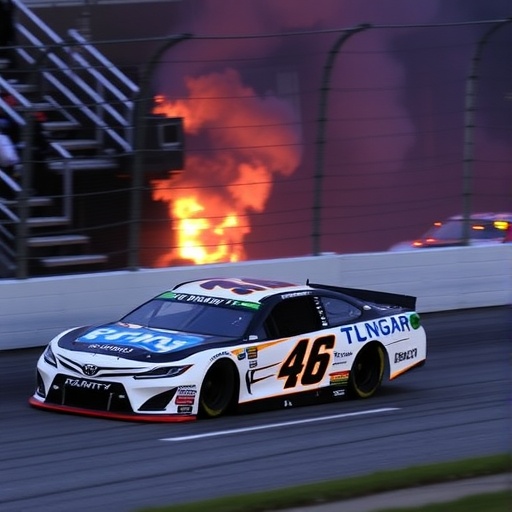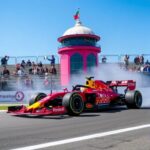NASCAR Playoffs Ignite: Xfinity 500 at Martinsville Speedway Sets Stage for Round of 8 Drama
In the heart-pounding world of NASCAR auto racing, where every lap can rewrite destinies, the Xfinity 500 at Martinsville Speedway stands as a make-or-break battleground. This Sunday’s race isn’t just another event on the calendar—it’s the decisive showdown that will cull the playoff field from eight elite drivers to just four championship hopefuls, thrusting the survivors into the high-stakes finale at Phoenix Raceway. With tensions boiling over from recent eliminations and underdog surges, fans are bracing for a spectacle of strategy, speed, and sheer willpower on the iconic half-mile paperclip track.
- Playoff Warriors on the Brink: Eight Drivers Battling for Advancement
- Martinsville’s Brutal Beauty: Why This Track Defines Playoff Intensity
- Key Strategies and Stats: How Teams Prep for Xfinity 500 Chaos
- Underdog Stories and Rivalries: Fueling the Playoff Fire
- Championship Horizon: What a Martinsville Win Means for the Finale
The NASCAR playoffs have already delivered edge-of-your-seat action this season, but the Xfinity 500 elevates the drama to fever pitch. Eight drivers enter with everything on the line: a win here could secure a spot in the Championship 4, while a poor finish might end dreams prematurely. As the sun sets on the Virginia mountains, Martinsville’s short, tight turns promise chaos, close-quarters battles, and potentially race-defining cautions that could flip the script in an instant.
Playoff Warriors on the Brink: Eight Drivers Battling for Advancement
The Xfinity 500 lineup reads like a who’s who of NASCAR‘s finest, each driver carrying the weight of their team’s season-long efforts. Leading the charge is William Byron, the Hendrick Motorsports star who’s been on a tear with two playoff wins already under his belt. Byron’s No. 24 Chevrolet has shown blistering speed on short tracks, but he’ll need to navigate the playoff pressure cooker without repeating last year’s mid-round stumble.
Close behind in points is Kyle Larson, the Hendrick teammate whose aggressive style has netted him three victories this year. Larson’s mastery of Martinsville—boasting a 95.4% average running position in recent races—makes him a favorite, but his penchant for bold moves could either propel him forward or spark a multi-car wreck. “Martinsville is like a chess game at 100 mph,” Larson said in a pre-race interview. “One wrong decision, and you’re out of the playoffs before you know it.”
Defending his aggressive edge is Denny Hamlin, the Joe Gibbs Racing veteran with a record-tying nine Martinsville wins. Hamlin enters the race just 12 points above the elimination line, making every practice lap crucial. His team’s pit strategy has been flawless in the playoffs, but rivals are gunning for payback after a contentious Kansas clash. Then there’s Joey Logano, the Team Penske driver who’s clawed his way back from early setbacks with a win at Charlotte. Logano’s experience in high-pressure scenarios—he’s a two-time champion—positions him as a dark horse, especially with his Ford’s superior short-track handling.
Rounding out the field are Christopher Bell, Ryan Blaney, Chase Elliott, and Tyler Reddick, each bringing unique strengths. Bell’s consistency has kept him afloat, while Blaney’s playoff pedigree shines through. Elliott, the 2020 champ, seeks redemption after a frustrating Bristol performance, and Reddick’s raw speed on restarts could be the X-factor. According to NASCAR stats, the average margin for advancement in this round has been a razor-thin 18 points over the last five years, underscoring the razor-edge competition.
Elimination looms large for those on the bubble. A single DNF (Did Not Finish) could drop a driver 40-50 points, based on historical data from Martinsville races. Fans recall the 2022 Xfinity 500, where Chase Briscoe’s last-lap pass sealed his advancement, leaving Bell and others heartbroken. This year’s field knows the stakes: only perfection—or close to it—will suffice.
Martinsville’s Brutal Beauty: Why This Track Defines Playoff Intensity
Martinsville Speedway, nestled in the Blue Ridge foothills since 1947, is more than a racetrack—it’s a proving ground that has shaped NASCAR legends. The 0.526-mile oval, with its high banks and paperclip shape, demands precision tire management and fearless short-track racing. At speeds topping 95 mph in the corners, drivers hug the wall mere inches from disaster, creating the kind of door-to-door action that has earned it the nickname “The Paperclip.”
Historically, Martinsville has hosted 57 Cup Series races, with an astonishing 55 different winners in playoff scenarios highlighting its unpredictability. The track’s short length—leading to 500 laps of non-stop intensity—amplifies every mistake. Data from the last decade shows an average of 12 cautions per Xfinity 500, often triggered by the “Martinsville Miracle” moments where late-race pileups reshuffle the order.
What sets Martinsville Speedway apart in the playoffs is its role as the Round of 8 eliminator. Since the playoff format’s inception in 2014, seven of the last ten champions have advanced through Martinsville with a top-five finish. The asphalt surface, repaved in 2023, has quickened lap times by 1.2 seconds on average, favoring teams with superior aero packages like those from Hendrick and Gibbs.
Weather could add another layer of intrigue; forecasts call for partly cloudy skies with temperatures in the low 60s, ideal for racing but prone to late-afternoon shadows that challenge visibility. Track president Clay Campbell emphasized the venue’s allure: “Martinsville isn’t just a race; it’s where heroes are made and seasons are saved. We’ve seen tears of joy and agony here more times than we can count.” For auto racing purists, this is the essence of why NASCAR captivates millions.
Beyond the track, the event draws over 50,000 fans annually, boosting local economies and fostering a community vibe with pre-race concerts and fan zones. The Xfinity 500’s broadcast on NBC promises cutting-edge coverage, including onboard cameras that capture the raw emotion of playoff pressure.
Key Strategies and Stats: How Teams Prep for Xfinity 500 Chaos
Preparation for the Xfinity 500 is a symphony of data and daring. Teams pore over telemetry from spring’s Martinsville visit, where Byron led 153 laps before fading to third. Current simulations predict tire wear as the biggest variable, with right-front degradation hitting 0.15 seconds per lap after 100 circuits. Crew chiefs like Byron’s Rudy Fugle are dialing in setups for maximum grip without overheating brakes—a balance that’s eluded many in past playoffs.
Points math is unforgiving: The top four in the Round of 8 standings—Larson, Byron, Hamlin, and Logano—hold a 20-30 point cushion, but a win awards 40 playoff points plus five bonus, potentially locking in advancement. Stats show that 60% of Xfinity 500 winners since 2017 were playoff drivers, underscoring the event’s championship gravity.
Recent form paints a vivid picture. In the prior playoff round at Kansas, Reddick’s third-place run showcased 23 Motorsports’ resurgence, while Elliott’s engine woes cost him dearly. Quote from Elliott: “We can’t afford another Martinsville mishap. This track punishes the unprepared.” Pit stops, averaging 13 seconds here, will be pivotal; teams practicing four-tire changes under 12 seconds could gain crucial track position.
Fuel strategy looms large too. With 500 miles to cover, mileage hovers at 4.5 mpg, meaning two full stops minimum. Underdogs like Blaney are banking on stage points—awarded at laps 130 and 260—to build buffers. Historical data reveals that leading the most laps correlates to a 75% advancement rate, pressuring frontrunners to push aggressively from the green flag.
In auto racing‘s broader context, the Xfinity 500 exemplifies NASCAR‘s evolution toward strategy over sheer power. Hybrid experiments in lower series hint at future changes, but for now, raw horsepower from 670-horsepower V8s rules the day at Martinsville Speedway.
Underdog Stories and Rivalries: Fueling the Playoff Fire
Amid the star power, underdogs add spice to the NASCAR playoffs. Tyler Reddick, starting from the 23XI Racing stable, has overcome a 15th-place regular-season finish to surge into contention. His Charlotte win wasn’t luck—Reddick’s 142 laps led that day mirrored his aggressive line choices, now honed for Martinsville’s turns. “I’m the hunter now,” Reddick quipped. “These guys have targets on their backs.”
Rivalries simmer too. Hamlin and Larson, teammates yet competitors, share a history of on-track skirmishes; a 2021 Martinsville clash saw Hamlin spin Larson out of the lead, costing points. This year, with playoff spots at stake, cooler heads—or hotter tempers—could prevail. Bell and Blaney, both seeking their first title, form an unlikely alliance against the veterans, their teams swapping setup data to counter the big three.
Fan narratives amplify the drama. Social media buzzes with #Xfinity500 hashtags, predicting wrecks and miracles. One viral clip from practice showed Logano’s near-miss with the wall, garnering 500,000 views. Stats from NASCAR‘s digital arm show a 25% uptick in playoff engagement, driven by these personal stories.
Women in racing get a nod too, with Hailie Deegan’s Xfinity Series success inspiring broader participation. Though not in the Cup field, her influence underscores auto racing‘s growing inclusivity, potentially paving paths for future playoff contenders.
The Xfinity 500 isn’t isolated; it ties into NASCAR‘s global appeal, with international viewers tuning in via streaming. Partnerships with brands like Xfinity highlight the event’s commercial pull, funding the sport’s future innovations.
Championship Horizon: What a Martinsville Win Means for the Finale
As the checkered flag waves on the Xfinity 500, the eyes of NASCAR nation turn to the Championship 4 at Phoenix on November 10. Advancing drivers will enter with reset points, facing a 312-lap shootout where the top finisher claims the 2024 title. A Martinsville victory not only secures that spot but boosts momentum—eight of the last ten champions won their elimination race.
For the victors, the path ahead involves fine-tuning for diverse tracks: Homestead, Martinsville redux in spirit, and Phoenix’s flat one-mile. Teams like Hendrick, with dual contenders, eye a sweep, echoing 2021’s dominance. Losers face offseason reflection, but playoffs history shows bounce-backs; eliminated drivers often return stronger.
NASCAR officials anticipate record viewership, building on the 5.2 million for last year’s finale. The Xfinity 500’s outcome could redefine legacies, spark sponsor deals, and set the tone for 2025’s Next Gen car tweaks. In auto racing, where fortunes flip faster than a spinout, Martinsville reminds us: the playoffs are won not just on speed, but on heart. As drivers strap in, one thing’s certain—this race will etch new chapters in NASCAR lore.










